Wai-Fah Chen.The Civil Engineering Handbook
Подождите немного. Документ загружается.

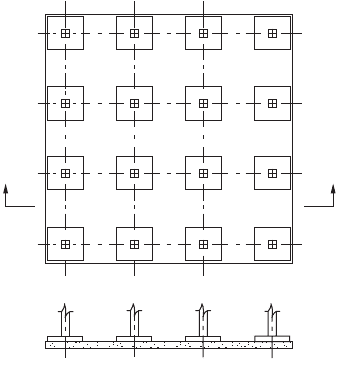
50-56 The Civil Engineering Handbook, Second Edition
or other causes. For this purpose, continuous spread foundations are frequently used in situations where
the superstructure or the type of occupancy provides unusual sensitivity to differential settlement.
Two-Column Footings
The ACI Code does not provide a detailed approach for the design of combined footings. The design,
in general, is based on an empirical approach. It is desirable to design combined footings so that the
centroid of the footing area coincides with the resultant of the two column loads. This produces uniform
bearing pressure over the entire area and forestalls a tendency for the footings to tilt. In plan, such footings
are rectangular, trapezoidal, or T shaped, the details of the shape being arranged to produce coincidence
of centroid and resultant. The simple relationships of Fig. 50.26 facilitate the determination of the shapes
of the bearing area [Fintel, 1985]. In general, the distances m and n are given, the former being the
distance from the center of the exterior column to the property line and the latter the distance from that
column to the resultant of both column loads.
Another expedient, which is used if a single footing cannot be centered under an exterior column, is
to place the exterior column footing eccentricity and to connect it with the nearest interior column by
a beam or strap. This strap, being counterweighted by the interior column load, resists the tilting tendency
of the eccentric exterior footings and equalizes the pressure under it. Such foundations are known as
strap, cantilever, or connected footings.
The strap may be designed as a rectangular beam spacing between the columns. The loads on it include
its own weight (when it does not rest on the soil) and the upward pressure from the footings. Width of
the strap usually is selected arbitrarily as equal to that of the largest column plus 4 to 8 inches so that
column forms can be supported on top of the strap. Depth is determined by the maximum bending
moment. The main reinforcing in the strap is placed near the top. Some of the steel can be cut off where
not needed. For diagonal tension, stirrups normally will be needed near the columns (Fig. 50.27). In
addition, longitudinal placement steel is set near the bottom of the strap, plus reinforcement to guard
against settlement stresses.
The footing under the exterior column may be designed as a wall footing. The portions on opposite
sides of the strap act as cantilevers under the constant upward pressure of the soil. The interior footing
should be designed as a single-column footing. The critical section for punching shear, however, differs
from that for a conventional footing. This shear should be computed on a section at a distance d/2 from
the sides and extending around the column at a distance d/2 from its faces, where d is the effective depth
of the footing.
FIGURE 50.25 Mat foundation. (Source: Wang and Salmon, 1985.)
a a
a-a
© 2003 by CRC Press LLC
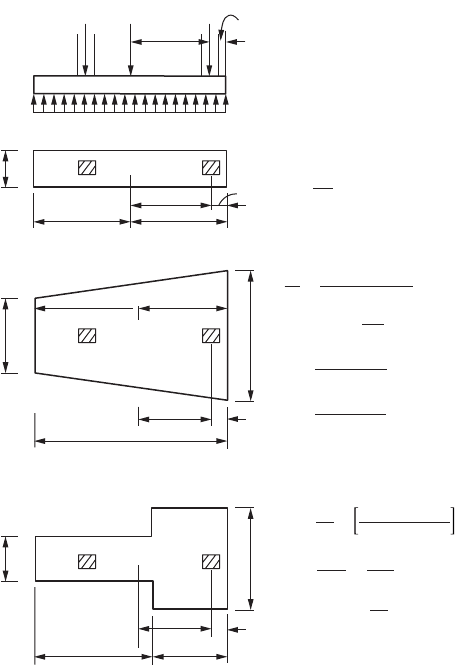
Structural Concrete Design 50-57
Strip, Grid, and Mat Foundations
In the case of heavily loaded columns, particularly if they are to be supported on relatively weak or
uneven soils, continuous foundations may be necessary. They may consist of a continuous strip footing
supporting all columns in a given row, or more often, of two sets of such strip footings intersecting at
right angles so that they form one continuous grid foundation (Fig. 50.24). For even larger loads or
weaker soils the strips are made to merge, resulting in a mat foundation (Fig. 50.25).
For the design of such continuous foundations it is essential that reasonably realistic assumptions be
made regarding the distribution of bearing pressures, which act as upward loads on the foundation. For
compressible soils it can be assumed in first approximation that the deformation or settlement of the
soil at a given location and the bearing pressure at that location are proportional to each other. If columns
are spaced at moderate distances and if the strip, grid, or mat foundation is very rigid, the settlements
in all portions of the foundation will be substantially the same. This means that the bearing pressure,
also known as subgrade reaction, will be the same provided that the centroid of the foundation coincides
with the resultant of the loads. If they do not coincide, then for such rigid foundations the subgrade
reaction can be assumed as linear and determine from statics in the same manner as discussed for single
footings. In this case, all loads — the downward column loads as well as the upward-bearing pressures —
are known. Hence, moments and shear forces in the foundation can be found by statics alone. Once
these are determined, the design of strip and grid foundations is similar to that of inverted continuous
beams, and design of mat foundations is similar to that of inverted flat slabs or plates.
FIGURE 50.26 Two-column footings. (Source: Fintel, 1985.)
P
1
c
1
l
1
l
2
c
2
P
2
R
C
m
n
b
b
1
b
1
b
2
b
2
n
n
m
m
n
m
l
/2
l
/2
x
C
x
C
x
l
l
= 2(
m
+
n
)
b
=
R
q
e
l
c
1
l
(
b
1
+2
b
2
)
3(
b
1
+
b
2
)
=
c
2
l
(2
b
1
+
b
2
)
3(
b
1
+
b
2
)
=
b
2
b
1
3(
n
+
m
) −
l
2
l
− 3(
n
+
m
)
=
(
b
1
+
b
2
)
2
R
q
e
l
=
R
q
e
=
l
1
b
1
+
l
2
b
2
b
2
R
l
2
q
e
=
l
1
b
1
l
2
−
b
1
R
q
e
=
=
l
1
(
l
1
+
l
2
)
2(
n
+
m
) −
l
2
© 2003 by CRC Press LLC
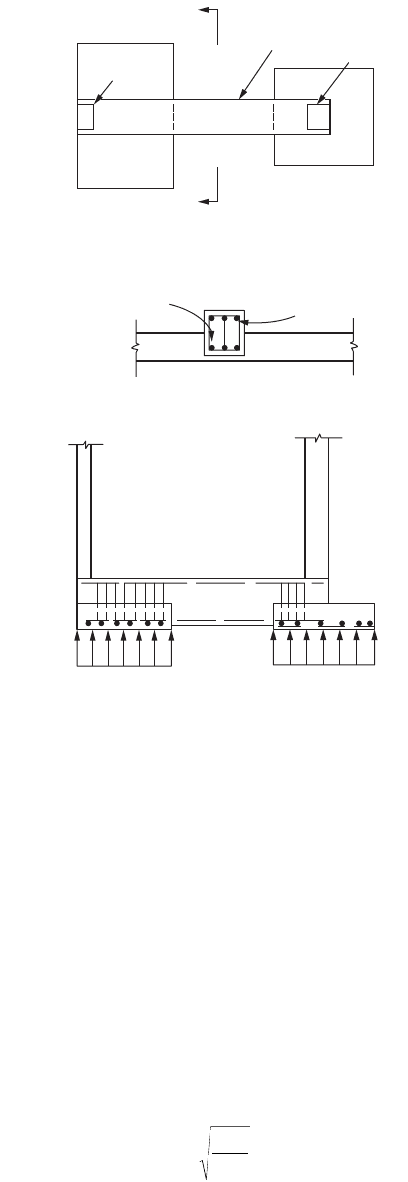
50-58 The Civil Engineering Handbook, Second Edition
On the other hand, if the foundation is relatively flexible and the column spacing large, settlements
will no longer be uniform or linear. For one thing, the more heavily loaded columns will cause larger
settlements, and thereby larger subgrade reactions, than the lighter ones. Also, since the continuous strip
or slab midway between columns will deflect upward relative to the nearby columns soil settlement —
and thereby the subgrade reaction — will be smaller midway between columns rather than directly at
the columns. This is shown schematically in Fig. 50.28. In this case the subgrade reaction can no longer
be assumed as uniform. A reasonably accurate but fairly complex analysis can then be made using the
theory of beams on elastic foundations.
A simplified approach has been developed that covers the most frequent situations of strip and grid
foundations [ACI Committee 436, 1966]. The method first defines the conditions under which a foun-
dation can be regarded as rigid so that uniform or overall linear distribution of subgrade reactions can
be assumed. This is the case when the average of two adjacent span lengths in a continuous strip does
not exceed 1.75/ l, provided also that the adjacent span and column loads do not differ by more than
20% of the larger value. Here,
(50.134)
FIGURE 50.27 Strap (cantilever) footing. (Source: Fintel, 1985.)
STRAP
(a) PLAN
MAIN STEEL
SETTLEMENT AND
PLACEMENT STEEL
(b) SECTION A-A
(c) ELEVATION
COLUMN
COLUMN
A
A
qq
l=4
3
kb
EI
s
c
© 2003 by CRC Press LLC
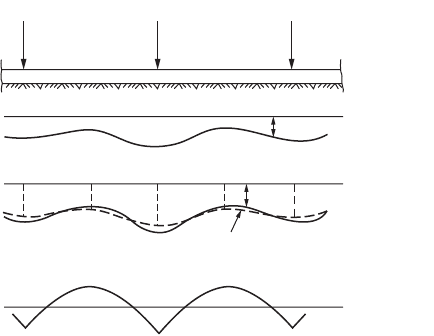
Structural Concrete Design 50-59
where k
s
= S k¢
s
k¢
s
=coefficient of subgrade reaction as defined in soils mechanics, basically force per unit area
required to produce unit settlement, kips/ft
3
b =width of footing, ft
E
c
=modulus of elasticity of concrete, kips/ft
2
I =moment of inertia of footing, ft
4
S = shape factor, being [(b + 1)/2b]
2
for granular soils and (n + 0.5)/1.5n for cohesive soils,
where n is the ratio of longer to shorter side of strip
If the average of two adjacent spans exceeds 1.75/l, the foundation is regarded as flexible. Provided
that adjacent spans and column loads differ by no more than 20%, the complex curvilinear distribution
of subgrade reaction can be replaced by a set of equivalent trapezoidal reactions, which are also shown
in Fig. 50.28. The report of ACI Committee 436 contains fairly simple equations for determining the
intensities of the equivalent pressures under the columns and at the middle of the spans and also gives
equations for the positive and negative moments caused by these equivalent subgrade reactions. With
this information, the design of continuous strip and grid footings proceeds similarly to that of footings
under two columns.
Mat foundations likewise require different approaches, depending on whether they can be classified
as rigid or flexible. As in strip footings, if the column spacing is less than 1/l, the structure may be
regarded as rigid, the soil pressure can be assumed as uniformly or linearly distributed, and the design
is based on statics. On the other hand, when the foundation is considered flexible as defined above, and
if the variation of adjacent column loads and spans is not greater than 20%, the same simplified procedure
as for strip and grid foundations can be applied to mat foundations. The mat is divided into two sets of
mutually perpendicular strip footings of width equal to the distance between midspans, and the distri-
bution of bearing pressures and bending moments is carried out for each strip. Once moments are
determined, the mat is in essence treated the same as a flat slab or plate, with the reinforcement allocated
between column and middle strips as in these slab structures.
This approach is feasible only when columns are located in a regular rectangular grid pattern. When
a mat that can be regarded as rigid supports columns at random locations, the subgrade reactions can
still be taken as uniform or as linearly distributed and the mat analyzed by statics. If it is a flexible mat
that supports such randomly located columns, the design is based on the theory of plates on elastic
foundation.
FIGURE 50.28 Strip footing. (Source: Fintel, 1985.)
P
1
<>
Settlement
Subgrade
reaction
q
Moment
diagram
Simplified
P
2
P
1
s
q
=
k
s
s
+
-
+
© 2003 by CRC Press LLC

50-60 The Civil Engineering Handbook, Second Edition
Footings on Piles
If the bearing capacity of the upper soil layers is insufficient for a spread foundation, but firmer strata
are available at greater depth, piles are used to transfer the loads to these deeper strata. Piles are generally
arranged in groups or clusters, one under each column. The group is capped by a spread footing or cap
that distributes the column load to all piles in the group. Reactions on caps act as concentrated loads at
the individual piles, rather than as distributed pressures. If the total of all pile reactions in a cluster is
divided by area of the footing to obtain an equivalent uniform pressure, it is found that this equivalent
pressure is considerably higher in pile caps than for spread footings. Thus, it is in any event advisable to
provide ample rigidity — that is, depth for pile caps — in order to spread the load evenly to all piles.
As in single-column spread footings, the effective portion of allowable bearing capacities of piles, R
a
,
available to resist the unfactored column loads is the allowable pile reaction less the weight of footing,
backfill, and surcharge per pile. That is,
(50.135)
where W
f
is the total weight of footing, fill, and surcharge divided by the number of piles.
Once the available or effective pile reaction R
e
is determined, the number of piles in a concentrically
loaded cluster is the integer next larger than
(50.136)
The effects of wind and earthquake moments at the foot of the columns generally produce an eccentrically
loaded pile cluster in which different piles carry different loads. The number and location of piles in
such a cluster is determined by successive approximation from the condition that the load on the most
heavily loaded pile should not exceed the allowable pile reaction R
a
. Assuming a linear distribution of
pile loads due to bending, the maximum pile reaction is
(50.137)
where P = the maximum load (including weight of cap, backfill, etc.)
M = the moment to be resisted by the pile group, both referred to the bottom of the cap
I
pg
= the moment of inertia of the entire pile group about the centroidal axis about which
bending occurs
c = the distance from that axis to the extreme pile
Piles are generally arranged in tight patterns, which minimizes the cost of the caps, but they cannot
be placed closer than conditions of deriving and of undisturbed carrying capacity will permit. AASHTO
requires that piles be spaced at least 2 ft 6 in. center to center and that the distance from the side of a
pile to the nearest edge of the footing be 9 in. or more.
The design of footings on piles is similar to that of single-column spread footings. One approach is
to design the cap for the pile reactions calculated for the factored column loads. For a concentrically
loaded cluster this would give R
u
= (1.4D + 1.7L)/n. However, since the number of piles was taken as the
next larger integer according to Eq. (50.137), determining R
u
in this manner can lead to a design where
the strength of the cap is less than the capacity of the pile group. It is therefore recommended that the
pile reaction for strength design be taken as
(50.138)
where the average load factor is (1.4D + 1.7L)/(D + L). In this manner the cap is designed to be capable
of developing the full allowable capacity of the pile group.
RRW
ea f
=-
n
DL
R
e
=
+
R
P
n
M
IC
pg
max
=+
RR
ue
=¥Average load factor
© 2003 by CRC Press LLC
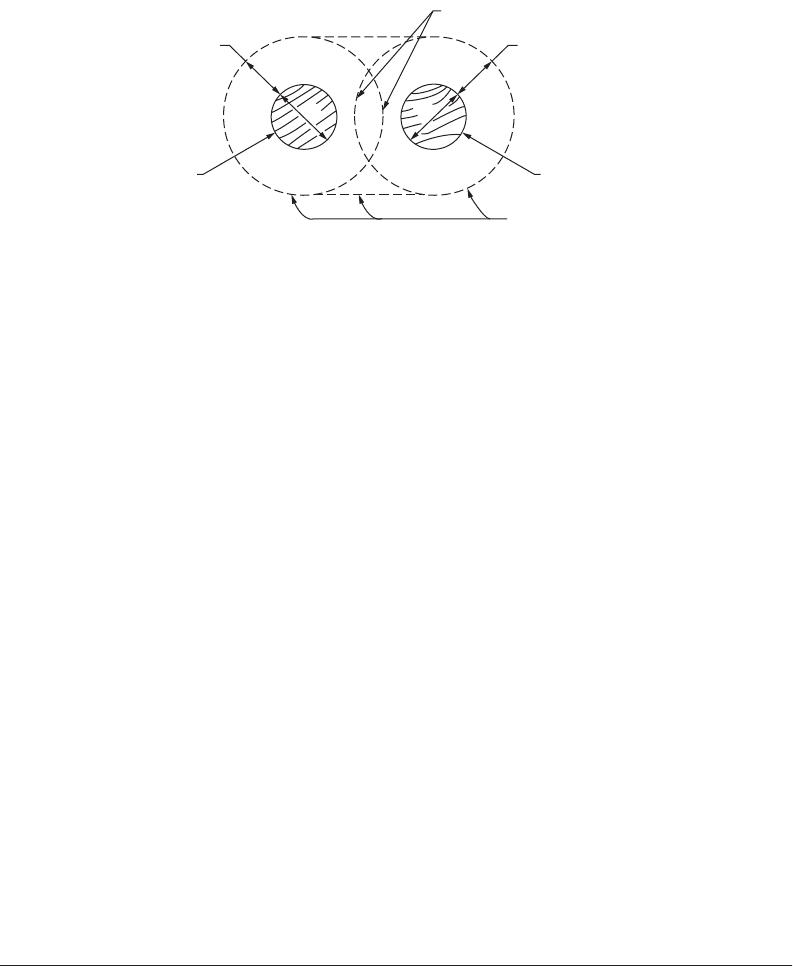
Structural Concrete Design 50-61
As in single-column spread footings, the depth of the pile cap is usually governed by shear. In this regard
both punching and one-way shear need to be considered. The critical sections are the same as explained
earlier under “Two-Way Shear (Punching Shear)” and “One-Way Shear.” The difference is that shears on
caps are caused by concentrated pile reactions rather than by distributed bearing pressures. This poses the
question of how to calculate shear if the critical section intersects the circumference of one or more piles.
For this case the ACI Code accounts for the fact that pile reaction is not really a point load, but is distributed
over the pile-bearing area. Correspondingly, for piles with diameters d
p
, it stipulates as follows:
Computation of shear on any section through a footing on piles shall be in accordance with the
following:
(a) The entire reaction from any pile whose center is located d
p
/2 or more outside this section
shall be considered as producing shear on that section.
(b) The reaction from any pile whose center is located d
p
/2 or more inside the section shall be
considered as producing no shear on that section.
(c) For intermediate portions of the pile center, the portion of the pile reaction to be considered
as producing shear on the section shall be based on straight-line interpolation between the
full value at d
p
/2 outside the section and zero at d
p
/2 inside the section [1992].
In addition to checking punching and one-way shear, punching shear must be investigated for the
individual pile. Particularly in caps on a small number of heavily loaded piles, it is this possibility of a
pile punching upward through the cap which may govern the required depth. The critical perimeter for
this action, again, is located at a distance d/2 outside the upper edge of the pile. However, for relatively
deep caps and closely spaced piles, critical perimeters around adjacent piles may overlap. In this case,
fracture, if any, would undoubtedly occur along an outward-slanting surface around both adjacent piles.
For such situations the critical perimeter is so located that its length is a minimum, as shown for two
adjacent piles in Fig. 50.29.
50.11 Walls
Panel, Curtain, and Bearing Walls
As a general rule, the exterior walls of a reinforced concrete building are supported at each floor by the
skeleton framework, their only function being to enclose the building. Such walls are called panel walls.
They may be made of concrete (often precast), cinder concrete block, brick, tile blocks, or insulated metal
panels. The thickness of each of these types of panel walls will vary according to the material, type of
construction, climatological conditions, and the building requirements governing the particular locality
in which the construction takes place. The pressure of the wind is usually the only load that is considered
in determining the structural thickness of a wall panel, although in some cases exterior walls are used as
diaphragms to transmit forces caused by horizontal loads down to the building foundations.
FIGURE 50.29 Modified critical section for shear with overlapping critical perimeters.
d
p
d
p
d/2
Pile
d/2
Overlap
Pile
Probable critical
section
© 2003 by CRC Press LLC

50-62 The Civil Engineering Handbook, Second Edition
Curtain walls are similar to panel walls except that they are not supported at each story by the frame
of the building; rather, they are self supporting. However, they are often anchored to the building frame
at each floor to provide lateral support.
A bearing wall may be defined as one that carries any vertical load in addition to its own weight. Such
walls may be constructed of stone masonry, brick, concrete block, or reinforced concrete. Occasional
projections or pilasters add to the strength of the wall and are often used at points of load concentration.
Bearing walls may be of either single or double thickness, the advantage of the latter type being that the
air space between the walls renders the interior of the building less liable to temperature variation and
makes the wall itself more nearly moistureproof. On account of the greater gross thickness of the double
wall, such construction reduces the available floor space.
According to ACI Code Sec. 14.5.2 the load capacity of a wall is given by
(50.139)
where fP
nw
=design axial load strength
A
g
=gross area of section, in.
2
l
c
=vertical distance between supports, in.
h = thickness of wall, in.
f = 0.7
and where the effective length factor k is taken as 0.8 for walls restrained against rotation at top or bottom
or both, 1.0 for walls unrestrained against rotation at both ends, and 2.0 for walls not braced against
lateral translation.
In the case of concentrated loads, the length of the wall to be considered as effective for each should
not exceed the center-to-center distance between loads; nor should it exceed the width of the bearing
plus 4 times the wall thickness. Reinforced concrete bearing walls should have a thickness of at least
1/25 times the unsupported height or width, whichever is shorter. Reinforced concrete bearing walls of
buildings should be not less than 4 in. thick.
Minimum ratio of horizontal reinforcement area to gross concrete area should be 0.0020 for deformed
bars not larger than #5 — with specified yield strength not less than 60,000 psi or 0.0025 for other
deformed bars — or 0.0025 for welded wire fabric not larger than W31 or D31. Minimum ratio of vertical
thermal area to gross concrete area should be 0.0012 for deformed bars not larger than #5 — with
specified yield strength not less than 60,000 psi or 0.0015 for other deformed bars — or 0.0012 for welded
wire fabric not larger than W31 or D31. In addition to the minimum reinforcement requirement, not
less than two #5 bars shall be provided around all window and door openings. Such bars shall be extended
to develop the bar beyond the corners of the openings but not less than 24 in.
Walls more than 10 in. thick should have reinforcement for each direction placed in two layers parallel
with faces of wall. Vertical and horizontal reinforcement should not be spaced further apart than three
times the wall thickness, or 18 in. Vertical reinforcement need not be enclosed by lateral ties if vertical
reinforcement area is not greater than 0.01 times gross concrete area, or where vertical reinforcement is
not required as compression reinforcement.
Quantity of reinforcement and limits of thickness mentioned above are waived where structural
analysis shows adequate strength and stability. Walls should be anchored to intersecting elements such
as floors, roofs, or to columns, pilasters, buttresses, and intersecting walls, or footings.
Basement Walls
In determining the thickness of basement walls, the lateral pressure of the earth, if any, must be considered
in addition to other structural features. If it is part of a bearing wall, the lower portion may be designed
either as a slab supported by the basement and floors or as a retaining wall, depending upon the type of
ffPfA
kl
h
nw c g
c
=
¢
-
Ê
Ë
Á
ˆ
¯
˜
È
Î
Í
Í
˘
˚
˙
˙
055 1
32
2
.
© 2003 by CRC Press LLC
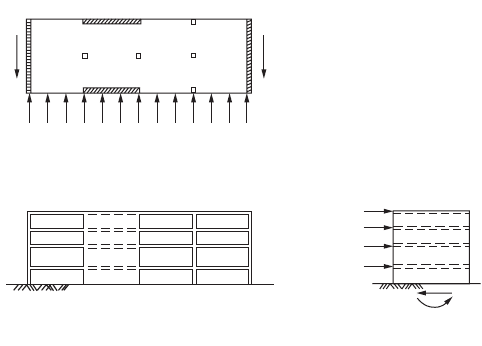
Structural Concrete Design 50-63
construction. If columns and wall beams are available for support, each basement wall panel of reinforced
concrete may be designed to resist the earth pressure as a simple slab reinforced in either one or two
directions. A minimum thickness of 7.5 in. is specified for reinforced concrete basement walls. In wet
ground a minimum thickness of 12 in. should be used. In any case, the thickness cannot be less than
that of the wall above.
Care should be taken to brace a basement wall thoroughly from the inside (1) if the earth is backfilled
before the wall has obtained sufficient strength to resist the lateral pressure without such assistance, or
(2) if it is placed before the first-floor slab is in position.
Partition Walls
Interior walls used for the purpose of subdividing the floor area may be made of cinder block, brick,
precast concrete, metal lath and plaster, clay tile, or metal. The type of wall selected will depend upon
the fire resistance required; flexibility of rearrangement; ease with which electrical conduits, plumbing,
etc., can be accommodated; and architectural requirements.
Shear Walls
Horizontal forces acting on buildings — for example, those due to wind of seismic action — can be
resisted by a variety of means. Rigid-frame resistance of the structure, augmented by the contribution
of ordinary masonry walls and partitions, can provide for wind loads in many cases. However, when
heavy horizontal loading is likely — such as would result from an earthquake — reinforced concrete
shear walls are used. These may be added solely to resist horizontal forces; alternatively, concrete walls
enclosing stairways or elevator shafts may also serve as shear walls.
Figure 50.30 shows a building with wind or seismic forces represented by arrows acting on the edge
of each floor or roof. The horizontal surfaces act as deep beams to transmit loads to vertical resisting
elements A and B. These shear walls, in turn, act as cantilever beams fixed at their base to carry loads
down to the foundation. They are subjected to (1) a variable shear, which reaches maximum at the base,
(2) a bending moment, which tends to cause vertical tension near the loaded edge and compression at
the far edge, and (3) a vertical compression due to ordinary gravity loading from the structure. For the
building shown, additional shear walls C and D are provided to resist loads acting in the log direction
of the structure.
FIGURE 50.30 Building with shear walls subject to horizontal loads: (a) typical floor; (b) front elevation; (c) end
elevation.
(b)
(a)
(c)
B
C
A
D
© 2003 by CRC Press LLC
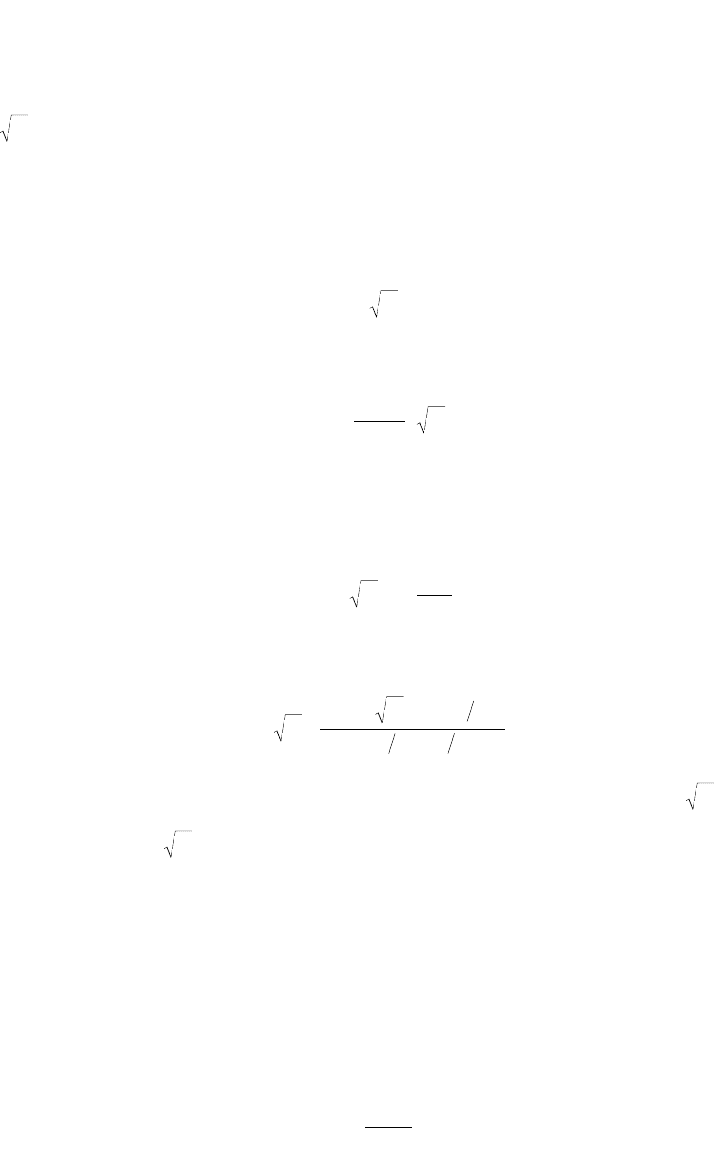
50-64 The Civil Engineering Handbook, Second Edition
The design basis for shear walls, according to the ACI Code, is of the same general form as that used
for ordinary beams:
(50.140)
(50.141)
Shear strength V
n
at any horizontal section for shear in plane of wall should not be taken greater than
10 h
d
. In this and all other equations pertaining to the design of shear walls, the distance of d may
be taken equal to 0.8l
w
. A larger value of d, equal to the distance from the extreme compression face to
the center of force of all reinforcement in tension, may be used when determined by a strain compatibility
analysis.
The value of V
c
, the nominal shear strength provided by the concrete, may be based on the usual
equations for beams, according to ACI Code. For walls subjected to vertical compression,
(50.142)
and for walls subjected to vertical tension N
u
,
(50.143)
where N
u
is the factored axial load in pounds, taken negative for tension, and A
g
is the gross area of
horizontal concrete section in square inches. Alternatively, the value of V
c
may be based on a more detailed
calculation, as the lesser of
(50.144)
or
(50.145)
Eq. (50.144) corresponds to the occurrence of a principal tensile stress of approximately 4 at the
centroid of the shear-wall cross section. Eq. (50.145) corresponds approximately to the occurrence of a
flexural tensile stress of 6 at a section l
w
/2 above the section being investigated. Thus the two equations
predict, respectively, web-shear cracking and flexure-shear cracking. When the quantity M
u
/V
u
– l
w
/2 is
negative, Eq. (50.145) is inapplicable. According to the ACI Code, horizontal sections located closer to
the wall base than a distance l
w
/2 or h
w
/2, whichever less, may be designed for the same V
c
as that
computed at a distance l
w
/2 or h
w
/2.
When the factored shear force V
u
does not exceed fV
c
/2, a wall may be reinforced according to the
minimum requirements given in Sec. 12.1. When V
u
exceeds fV
c
/2, reinforcement for shear is to be
provided according to the following requirements.
The nominal shear strength V
s
provided by the horizontal wall steel is determined on the same basis
as for ordinary beams:
(50.146)
VV
un
£f
VVV
ncs
=+
¢
f
c
Vfhd
cc
=
¢
2
V
N
A
fhd
c
u
g
c
=+
Ê
Ë
Á
ˆ
¯
˜
¢
21
500
Vfhd
Nd
l
cc
u
w
=
¢
+33
4
.
Vf
lfNlh
MV l
hd
cc
wcuw
uu w
=
¢
+
¢
+
()
-
È
Î
Í
Í
˘
˚
˙
˙
06
125 02
2
.
..
¢
f
c
¢
f
c
V
Afd
s
s
vy
=
2
© 2003 by CRC Press LLC
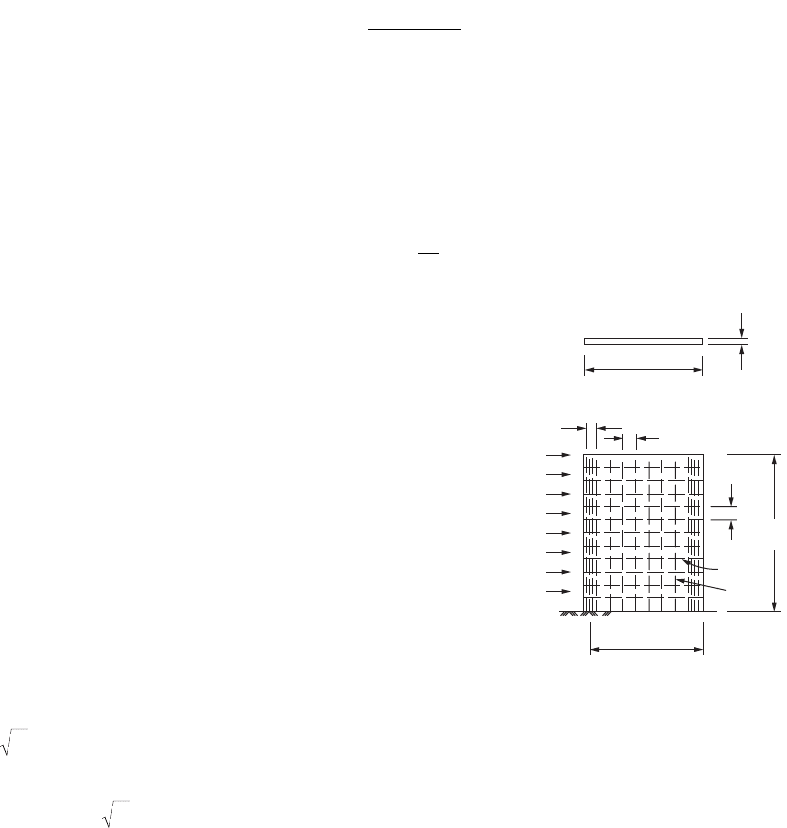
Structural Concrete Design 50-65
where A
v
= the area of horizontal shear reinforcement within vertical distance s
2
(in.
2
)
s
2
= the vertical distance between horizontal reinforcement, (in.)
f
y
= the yield strength of reinforcement, psi
Substituting Eq. (50.146) into Eq. (50.141), then combining with Eq. (50.140), one obtains the equation
for the required area of horizontal shear reinforcement within a distance s
2
:
(50.147)
The minimum permitted ratio of horizontal shear steel to gross concrete area of vertical section, r
n
, is
0.0025 and the maximum spacing s
2
is not to exceed l
w
/5, 3h, or 18 in.
Test results indicate that for low shear walls, vertical distributed reinforcement is needed as well as
horizontal reinforcement. Code provisions require vertical steel of area A
h
within a spacing s
1
, such that
the ratio of vertical steel to gross concrete area of horizontal section will not be less than
(50.148)
nor less than 0.0025. However, the vertical steel ratio need not be
greater than the required horizontal steel ratio. The spacing of the
vertical bars is not to exceed l
w
/3, 3h, or 18 in.
Walls may be subjected to flexural tension due to overturning
moment, even when the vertical compression from gravity loads is
superimposed. In many but not all cases, vertical steel is provided,
concentrated near the wall edges, as in Fig. 50.31. The required steel
area can be found by the usual methods for beams.
The ACI Code contains requirements for the dimensions and
details of structural walls serving as part of the earthquake-force
resisting systems. The reinforcement ratio, r
v
(= A
sv
/A
cv
; where A
cv
is
the net area of concrete section bounded by web thickness and length
of section in the direction of shear force considered, and A
sv
is the
projection on A
cv
of area of distributed shear reinforcement crossing
the plane of A
cv
), for structural walls should not be less than 0.0025
along the longitudinal and transverse axes. Reinforcement provided
for shear strength should be continuous and should be distributed
across the shear plane. If the design shear force does not exceed A
cv
, the shear reinforcement may conform to the reinforcement ratio
given in Sec. 12.1. At least two curtains of reinforcement should be
used in a wall if the in-plane factored shear force assigned to the wall
exceeds 2A
cv
. All continuous reinforcement in structural walls should be anchored or spliced in
accordance with the provisions for reinforcement in tension for seismic design.
Proportioning and details of structural walls that resist shear forces caused by earthquake motion is
contained in the ACI Code Sec. 21.7.3.
References
ACI Committee 318. 1992. Building Code Requirements for Reinforced Concrete and Commentary, ACI
318-89 (Revised 92) and ACI 318R-89 (Revised 92) (347 pp.). Detroit, MI.
ACI Committee 340. 1990. Design Handbook in Accordance with the Strength Design Method of ACI 318-
89. Vol ume 2, SP-17 (222 pp.).
A
VVs
fd
v
uc
y
=
-
()
f
f
2
rr
n
w
w
h
h
l
=+ -
Ê
Ë
Á
ˆ
¯
˜
-
()
0 0025 0 5 2 5 0 0025... .
FIGURE 50.31 Geometry and
reinforcement of typical shear wall;
(a) cross section; (b) elevation.
l
w
h
h
w
A
s
A
v
A
h
s
1
s
2
d
(b)
(a)
¢
f
c
¢
f
c
© 2003 by CRC Press LLC
